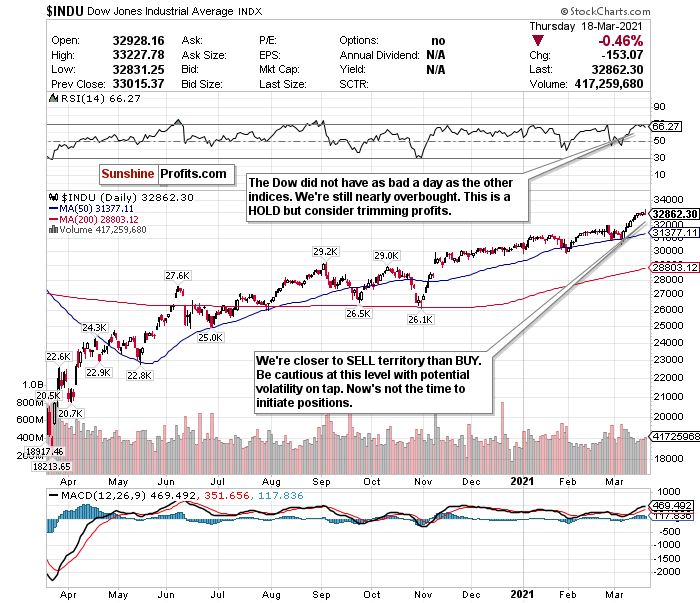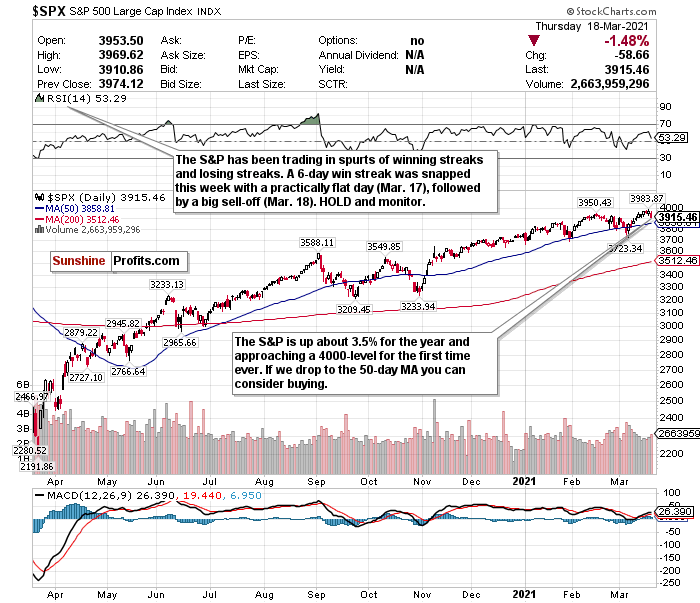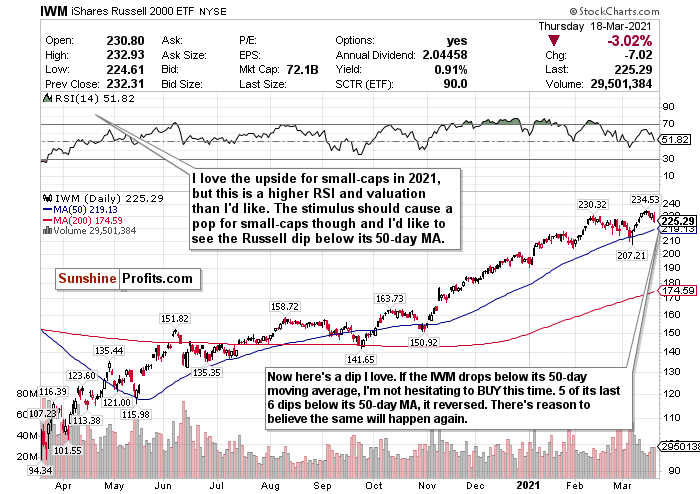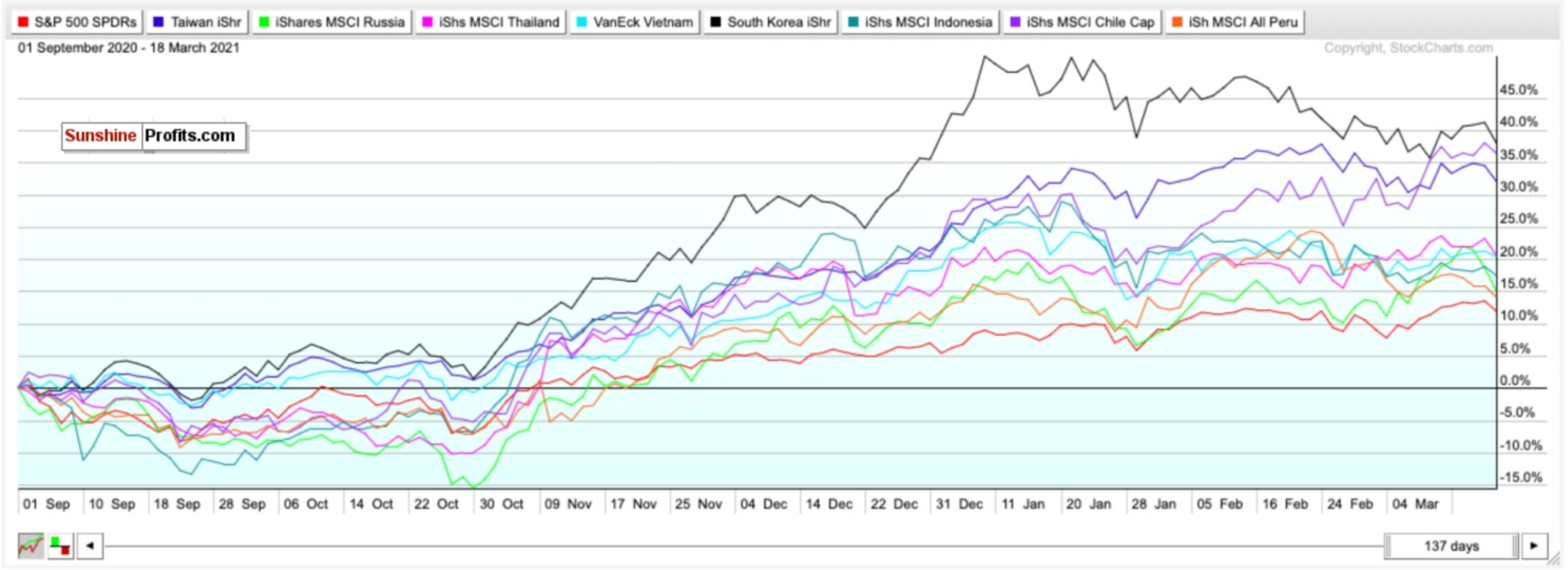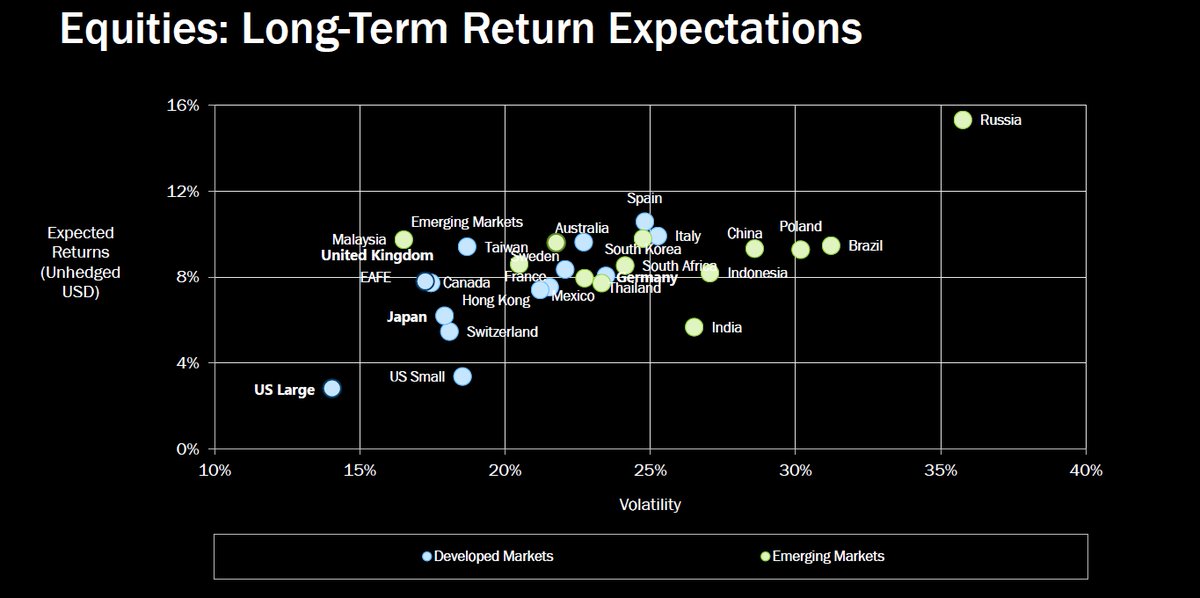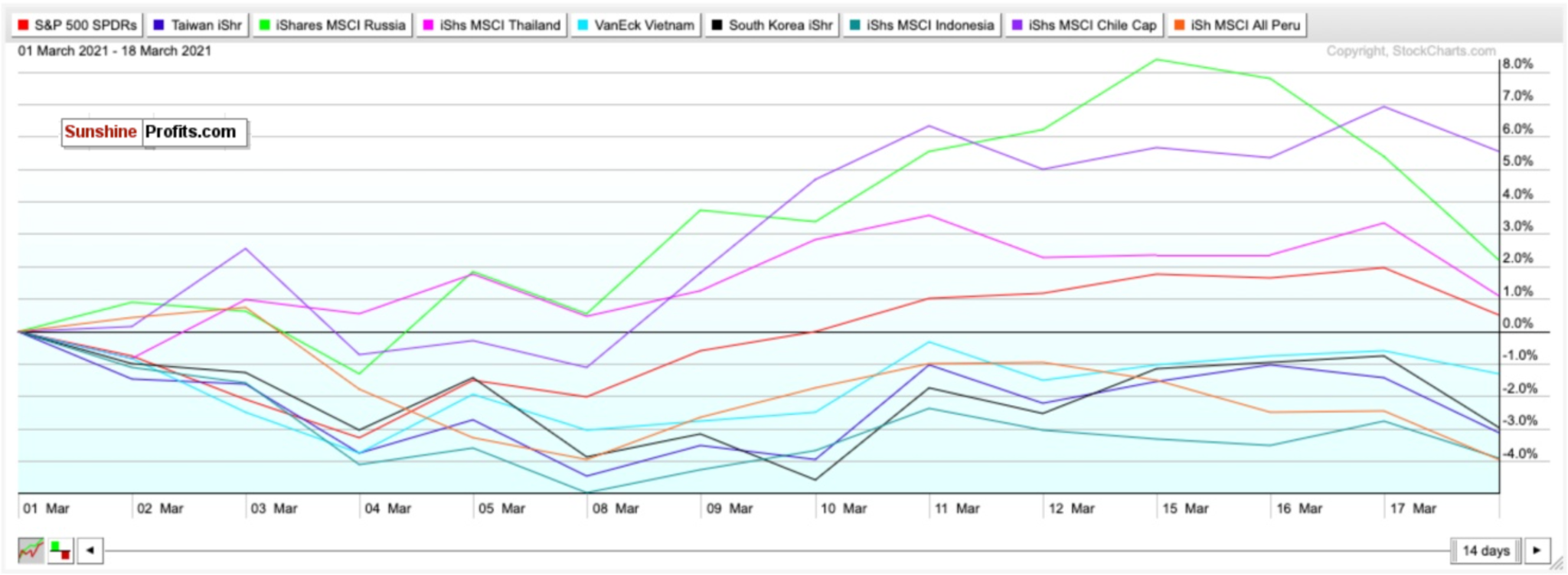March Madness started on Thursday (Mar. 18), but stocks got the jump on their own brackets this week. Let’s dive in.
Although Wednesday (Mar. 17) saw the indices have a nice St. Patrick’s day green reversal thanks to Jay Powell babying us on inflation thoughts again, Mr. Market isn't stupid. Manic, but not stupid. We saw a return to the strong rotation trend out of growth stocks the day after Powell's testimony (Mar. 18).
Thursday (Mar. 18) saw bond yields surge to their highest levels in what seems like forever. The 10-year yield popped 11 basis points to 1.75% for the first time since January 2020, while the 30-year rate climbed 6 basis points and breached 2.5% for the first time since August 2019.
Predictably, the Nasdaq tanked by over 3% for its worst session in 3-weeks.
Jay Powell and bond yields are the most significant market movers in the game now. Get ready for the market next week when he testifies to Congress. That'll be a beauty. What's coronavirus anymore?
So after what's been a relatively tame week for the indices, we can officially say bye-bye to that.
Bond yields, though, are still at historically low levels, and the Fed Funds Rate remains at 0%. With the Fed forecasting a successful economic recovery this year, with GDP growth of around 6.5% -- the fastest in nearly four decades -- the wheels could be in motion for another round of the Roaring '20s.
The problem, though, is that the Great Depression came right after the first Roaring '20s.
Many are sounding the alarm. However, like CNBC's Jim Cramer, others think the current headwinds are overblown, and a mirror of the 2015-2016 downturn is based on similar catalysts.
Figure 1: Jim Cramer Twitter
Cramer argued that Powell is a talented central banker willing to "let the economy continue to gain strength so that everyone has a chance to do well."
Nobody can predict the future, and these growth stock jitters from rising bond yields may be overblown. But for now, it's probably best to let the market figure itself out and be mindful of the headwinds.
My goal for these updates is to educate you, give you ideas, and help you manage money like I did when I was pressing the buy and sell buttons for $600+ million in assets. I left that career to pursue one to help people who needed help instead of the ultra-high net worth.
With that said, to sum it up:
There is optimism but signs of concern. The market has to figure itself out. A further downturn is possible, but I don’t think that a decline above ~20%, leading to a bear market, will happen any time soon.
Hopefully, you find my insights enlightening. I welcome your thoughts and questions and wish you the best of luck.
Is the Dow *Gulp* Overbought?
Figure 2- Dow Jones Industrial Average $INDU
Not much new to report on this. Except for that, it keeps hovering around a record high and overbought territory. We really have not moved much at all this week and are nowhere near a buyable point.
Having Dow exposure can be a good hedge if you’re heavily exposed to growth stocks. But at this level, it’s probably better to HOLD and let it ride, and maybe even consider trimming some profits.
Nobody ever lost money by taking profits.
The index could greatly benefit from the stimulus package and current monetary policy due to its cyclical stocks. I can definitely foresee some pops in the index as investors digest the unprecedented amount of money being pumped into the economy, coupled with reopening excitement.
But you can’t expect the index to keep going up like this and setting records every other day. Plus, the RSI is around 66 and showing overbought signs.
So, where do we go from here?
Many analysts believe the index could end the year at 35,000, and the wheels are in motion for a furious rally. But you could do better for a buyable entry point.
From my end, I’d prefer to stay patient, vigilant and find better buying opportunities.
My call on the Dow stays a HOLD, but we’re approaching SELL.
For an ETF that aims to correlate with the Dow’s performance, the SPDR Dow Jones ETF (DIA) is a reliable option.
Which Direction Could the Streaky S&P Go?
Figure 3- S&P 500 Large Cap Index $SPX
The S&P 500 is a complex index to call. It’s incredibly streaky and is between a rock and a hard place right now. It’s probably better to monitor the streakiness for now until it hits a buyable level.
We’re near a record high, close to a 4000 level for the first time in history, while amid a two-day losing streak after a 6-day winning streak.
This is simply not behaving like a buyable index. It’s best to be patient and see what happens.
I also think that we could meet some short-term resistance at the level we’re at right now. 4000 is a natural barrier until we get some clarity on the economy.
Unless I see some sort of buy or sell signal for the S&P 500, I think we’ll keep playing this game.
HOLD for now, but be prepared to either BUY or SELL depending on its moves. For an ETF that attempts to directly correlate with the performance of the S&P 500, the S&P 500 SPDR ETF (SPY) is a great option.
Russell 2000- Lessons Learned
Figure 4- iShares Russell 2000 ETF (IWM)
Aggressive stimulus, friendly policies, and a reopening world bode well for small-caps in 2021. I think this is something you have to consider for the Russell 2000 and maybe overpay for. But, I think I’m starting to figure this index out.
I have been kicking myself for not calling BUY on the Russell after it saw a minor downturn in the second half of February. I may have broken my own rule about “not timing the market” also. I’ve wanted to buy the Russell 2000 badly forever but never thought it dipped hard enough (whenever it did). I was waiting for it to at least approach a correction.
But I think I figured out a pattern now. Notice what happened with the Russell almost every time it touched or minorly declined below its 50-day moving average. It reversed.
Look at the above chart. Excluding the large crash and subsequent recovery in late-March and April 2020, 5 out of the last 6 times the Russell did this with its 50-day, it saw a sharp reversal. The only time it didn’t was in October 2020, when the distance between its 50-day and its 200-day moving average was a lot more narrow.
I loved Thursday’s (Mar. 18) decline. If the iShares Russell 2000 ETF (IWM) has another day like this and dips below its 50-day MA, I’m buying. Plain and simple.
The IWM has been on quite a run since November and year-to-date. This is the one reason why I’m more cautious about buying the index.
Since the market’s close on October 30, the IWM has gained about 47.59% and more than doubled almost every index-mirroring ETFs’ returns.
Not to mention, year-to-date, it’s up 16.4%.
I’m keeping this a HOLD. But I am monitoring the Russell 2000 closely for a bigger dip.
Beware of Inflation
Not to beat this same drum again, but this is the biggest market mover right now by far.
We need some clarity- is inflation really coming back, or is all this fear overblown?
On the one hand, all of this stimulus coupled with a dovish Fed make inflation a foregone conclusion. The Fed is clearly going to tolerate inflation, and we could see it hit 2.2% by the end of the year- about 20 basis points ahead of the Fed's benchmark target.
Plus, Moody's Analytics chief economist Mark Zandi feels that investors have not fully grasped that inflation is "dead ahead" and are grossly underestimating its seriousness and effect on every sector in the market.
On the other hand, BoA, in a March 10 note, described inflation as "well-contained." The bank also said that inflation fears would subside by the end of the year and expects CPI inflation to be well shy of the Fed's 2% target and hit 1.7% by the year's end.
As mentioned in the intro, CNBC personality Jim Cramer thinks this is a temporary hiccup that the market needs to figure out, similar to what happened between December 2015 and February 2016.
It's great that the Fed is hopeful on a 6.5% GDP recovery, but if they keep rates at 0% through 2023, it won't be sustainable with this growth rate. If they're forced to hike rates before they want to, it could be very, very bad for stocks.
Five-year inflation expectations have also more than doubled from last year's low and are now at around their highest levels since 2013.
"The rich world has come to take low inflation for granted. Perhaps it shouldn't." -The Economist.
As hedges against inflation, consider BUYING the SPDR TIPS ETF (SPIP), the Invesco Optimum Yield Diversified Commodity Strategy No K-1 ETF (PDBC), and the iShares Cohen & Steers REIT ETF (ICF).
Mid-Term/Long-Term
Add Emerging Market Exposure- Period
Figure 5- SPY, EWT, ERUS, THD, VNM, EWY, EIDO, ECH, EPU comparison chart- Sep. 1, 2020-Present
Since September, the SPDR S&P 500 ETF (SPY) has gained around 11.95%.
But if you compare that yield to that of my top emerging market picks for 2021, it has underperformed.
Consider this too.
With inflation on the horizon, a surge in commodity prices combined with shifting demographics could send other emerging markets upwards long-term. Plus, with birth rates plummeting during the pandemic in developed markets, it could mean long-term upside for emerging markets.
PWC echoes this sentiment and believes that emerging markets (E7) could grow around twice as fast as advanced economies (G7) on average in the coming decades.
For 2021, the following are my BUYs for emerging markets and why:
iShares MSCI Taiwan ETF (EWT)- Developing country, with stable fundamentals, diverse and modern hi-tech economy, regional upside without China’s same geopolitical risks.
iShares MSCI Thailand ETF (THD)- Bloomberg’s top emerging market pick for 2021 thanks to abundant reserves and a high potential for portfolio inflows. Undervalued compared to other ETFs.
iShares MSCI Russia Capped ETF (ERUS)- Bloomberg’s second choice for the top emerging market in 2021 thanks to robust external accounts, a robust fiscal profile, and an undervalued currency. Red-hot commodity market, growing hi-tech and software market, increasing personal incomes. Russian equities may also have potential upside north of 35%.
Figure 6- Equities: Long-Term Return Expectations Developed Markets/Emerging Markets
VanEck Vectors Vietnam ETF Vietnam (VNM)-Turned itself into an economy with a stable credit rating, strong exports, and modest public debt relative to growth rates. PWC believes Vietnam could also be the fastest-growing economy globally. It could be a Top 20 economy by 2050.
iShares MSCI South Korea ETF (EWY)- South Korea has a booming economy, robust exports, and stable yet high growth potential. The ETF has been the top-performing emerging market ETF since March 23.
iShares MSCI Indonesia ETF (EIDO)- Largest economy in Southeast Asia with young demographics. The fourth most populous country in the world. It could be less risky than other emerging markets while simultaneously growing fast. It could also be a Top 5 economy by 2050.
iShares MSCI Chile ETF (ECH)- One of South America’s largest and most prosperous economies. An abundance of natural resources and minerals. World’s largest exporter of copper. Could boom thanks to electric vehicles and batteries because of lithium demand. It is the world’s largest lithium exporter and could have 25% of the world’s reserves.
iShares MSCI Peru ETF (EPU)- A smaller developing economy but has robust gold and copper reserves and rich mineral resources.
Let’s take a look at how these emerging markets performed in March thus far.
Figure 7- SPY, EWT, ERUS, THD, VNM, EWY, EIDO, ECH, EPU comparison chart- March 1-Present
It’s been an up and down month for emerging markets, but Chile has been the only consistently outperforming ETF, rising to the tune of 5.55% month to date. Rising commodity prices are once again the big story, and Chile has a lot of them.
Remember. Chile is one of Latin America’s most robust economies and the world’s largest copper and lithium exporter. It could, in fact, have 25% of the world’s lithium reserves.
Outside of the aforementioned country-specific ETFs, you can also BUY the iShares MSCI Emerging Index Fund (EEM) for broad exposure to Emerging Markets.
Long-Term
I remain convinced that the economic recovery is going better than expected as the progress in administering the vaccines improves. But it’s a blessing and a curse if it goes “too well.”
Continue to pay attention to complacency, overvaluation, bond yields, and especially inflation.
Once again- Jay Powell will move the markets.
Time will tell what happens. There could be more short-term swings. But the economic climate is reopening, and things look a bit sunnier than they did at this time a year ago.
I think we could see some more swings as the market figures out bond yields and inflation. We may be at the beginning of the end of the pandemic, and 2021 should be a big year for stocks despite some choppy waters.
Summary
I cannot stress this enough. Play volatility to your advantage, and do not try to time the market. There are some concerns, but the overall backdrop right now is favorable for stocks.
Do not get caught up in fear and most of all:
NEVER TRADE WITH EMOTIONS.
Consider this too. You can sit out and be scared and wait for the perfect buying opportunity all you want. But we are almost a year out from March 23rd, 2020- the day that the market finally bottomed. If you bought ANY of these index-tracking ETFs on March 23rd when it looked like the world was ending, here is how you would have fared: Russell 2000 (IWM) up 128.68%. Nasdaq (QQQ) up 83.98%. Dow Jones (DIA) up 79.70%. S&P 500 (SPY) up 77.82%.
Nobody knows “where” the actual bottom is for stocks. However, in the long-term, markets always move higher and focus on the future rather than the present.
For now, even though bond yields and inflation appear to have stabilized, I’m still a bit concerned. Powell could significantly affect this too.
This $1.9 trillion rescue deal may be a short-term catalyst for stocks. But it’s only prolonging the inevitable. Inflation will eventually return with a vengeance. Bond yields will ultimately rise even more as the GDP heats up, and debt will continue to grow.
But for now? Enjoy the ride. Just maybe avoid filling gas. It’s getting ugly out there.
To sum up my calls:
I have HOLD calls for:
- The Invesco QQQ ETF (QQQ),
- the iShares Russell 2000 ETF (IWM),
- the SPDR S&P ETF (SPY), and
- the SPDR Dow Jones ETF (DIA)
I also recommend selling or hedging the US Dollar and gaining exposure into emerging markets for the mid-term and long-term.
I have BUY calls on:
- The iShares MSCI Emerging Index Fund (EEM),
- the iShares MSCI Taiwan ETF (EWT),
- the iShares MSCI Thailand ETF (THD),
- the iShares MSCI Russia ETF (ERUS),
- the VanEck Vectors Vietnam ETF (VNM),
- the iShares MSCI South Korea ETF (EWY),
- the iShares MSCI Indonesia ETF (EIDO),
- the iShares MSCI Chile ETF (ECH),
- and the iShares MSCI Peru ETF (EPU)
Additionally, because inflation has already crept back; and I foresee it getting worse as early as mid to late 2021…
I have BUY calls on:
- The SPDR TIPS ETF (SPIP),
- the Invesco Optimum Yield Diversified Commodity Strategy No K-1 ETF (PDBC), and
- the iShares Cohen & Steers REIT ETF (ICF)
Thank you.
Matthew Levy, CFA
Stock Trading Strategist



